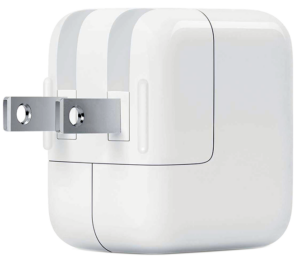
At this point, your iPad should be ready for normal daily use for learning! Work with your family to finish up these last few items, as they need some agreement!
Using the iPad
Do not eat or drink while using the iPad, or have food or drink near the iPad at any time. Do not leave the iPad in a place where it can be stepped on, sat on, dropped, or have liquid spilled on it. When moving the iPad from place to place, carry it with both hands.
Do not let pets touch or sleep on the iPad. (It has happened!)
Never hit the iPad or hit something else with the iPad. Never use anything but your finger to touch the screen, and you don’t need to press very hard when you do use your finger. You do not need to use a stylus or pencil on the iPad.
Never put anything into the headphone port except a headphone jack, and when you put it in and remove it, hold the plug, not the cable. One of the most common problems with iPads is a broken-off headphone jack stuck in the hole!
Be careful when opening or closing the kickstand on the back of the iPad.
Charging
Decide on a safe place to charge the iPad when not in use. Plug the charger, sometimes called a “power brick,” into the wall.

Plug the Lightning cable’s USB end into the brick (it will only fit one way), then plug the Lightning end into the iPad. Always hold the cable ends when plugging and unplugging them; never pull on the cable itself.

At the end of the learning day, be sure to plug your iPad in to charge.
If for some reason you forget, you can use the iPad when it is plugged in to the charger. Be careful not to pull on the cable accidentally.
Technical note for adults: You can use any standard USB charger that is rated at 2.0A or better. The back of any quality charger will show the amperage rating as a number followed by a capital letter “A,” often in very tiny print. The old, small iPad charging bricks from older Apple devices are only rated for 1.0A and will charge these iPads very slowly. They should be avoided. If you use a charger other than the one APS issued you, please carefully store the APS charger, as it is school property and will need to be returned. If you accidentally damage a charger or cable, you can replace them with a standard charger and cable, as it does not matter which one is returned, so long as the same type is returned.
Storage
Decide on a safe place to store the iPad when it is not in use and it is not charging. Some families like to leave the iPad on the charger overnight. This is completely fine! Other families like to lock the iPad up at night. That, too, is completely fine!
However your family wants to manage the iPad’s charging and use is okay, so long as the iPad is charged every day, and kept safe.
Cleaning
Never remove the case from the iPad. This will ensure the iPad inside the case stays clean and safe.
For information from Apple on how to care for their devices, click here.
To disinfect and clean the device, apply a mist of liquid (not gel) alcohol disinfectant to a clean cotton cloth or paper towel, wipe the surfaces with the cloth, and let the device air dry completely. Do not spray cleaner or liquid directly onto the device.
Do not use household cleaners or water to clean the iPad.
Apple ID, Passcodes, and Siri
Remember the instructions from the setup procedure:
Do not add an Apple ID to the APS-owned iPad. Do not set a passcode or screen lock. If you need to secure the device, physically lock it up. Do not configure Siri; if prompted to set up Siri, select “not now” or whichever option says “no.”
Getting Help
If you ever have a problem with your iPad, come back to this website and go to the iPads: Start Here page, which you can find easily at https://discovery.apsva.us/ipad. Choose the buttons that describe your situation, and the website will lead you to the answers you need!
 |
 Contact
Contact  Calendars
Calendars Careers
Careers Engage
Engage  District
District

